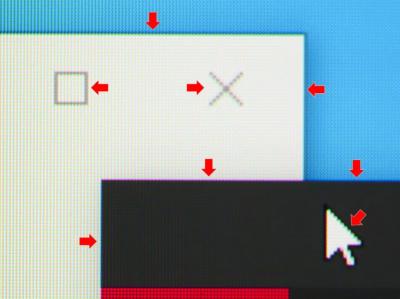Products with Samsung's QD-OLED panels are now hitting the market, led by Dell's Alienware AW3423DW gaming. A German magazine reviewed the 34" monitor, and discovered an issue with color inaccuracies.

As you can see in the photo, when there's a change from a dark color to a bright color, the display shows green lines that should not be there.
The cause of this is likely Samsung's unique "triangular" pixel structure, which means that the subpixels are arranged in a triangle:
![]()
There was speculation that the problem is Samsung's use of a Pentile architecture in these QD-OLED panels. But this is a not a Pentile display - for every pixel we have three sub pixels, red, green and blue.
Samsung responded to the color issues reported above:
"It is not a typical RGB stripe pixel but our proprietary structure optimized to enhance the core user experience of color and HDR. We selected this new pixel structure in order to optimize optical characteristics of QD-Display like brightness, color gamut and durability. Each pixel of QD-Display has an individual Red, Green and Blue 3 primary sub pixels.
Unlike Pentile sub-pixel structure that share the adjacent sub-pixel and compromise on detail and accuracy, QD-Display has 3 (R,G,B) x (3440*1440) sub-pixels. So, QD display does not compromise on the detail and accuracy.
The artifact pointed out also can be seen on conventional LCD and OLED displays using RGB stripe. Similar phenomenon is observed on the sides (Left and Right) side when displaying bright high contrast edge on conventional display products," Samsung Display told FlatpanelsHD. "Displays with better contrast modulation performance and wider color gamut and greater contrast ratio will accentuate this artifact. Because QD-Display has the widest color gamut, superior contrast ratio and new sub pixel structure, this artifact could be visible."
Comments
Thanks Pasha. We updated our post with more info and a photo of Samsung's QD-OLED pixel structure.
it looks like image rendering algorithm issue related to sub-pixel structure, not panel itself.
the monitor doesn't use Sub-Pixel rendering at all.
Very similar to convergence errors on the old Delta tube CRTs.
not only do we know it's not pentile it also sounds like the wrong terminology cos that looks like colour fringing which could be a plethora of issue causing it


We have already known for a fact (from the photos, as well) that the pixel structure for all of the current QD-OLED panels is triangular - not PenTile.